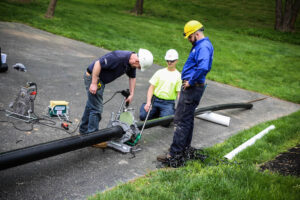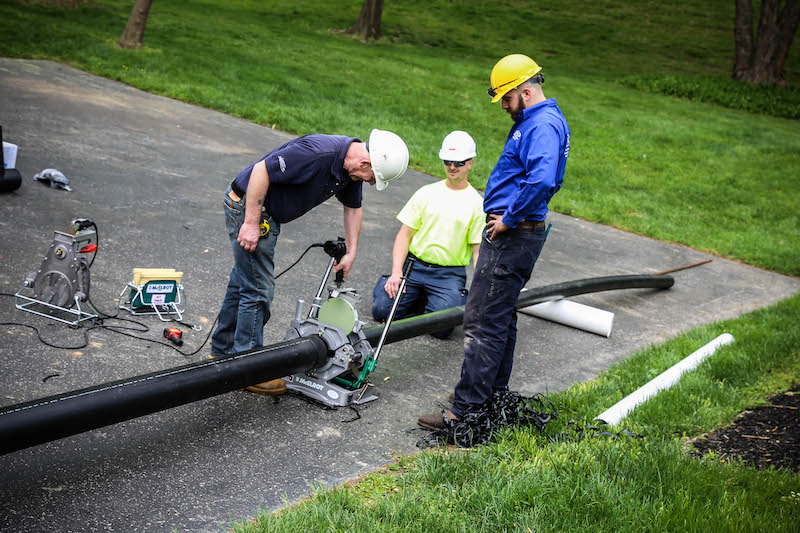A broken sewer line can lead to a lot of different issues, including squelching noises from the ground, moist soil around your home’s foundation, and foul odors. It’s important to take action as soon as you notice these symptoms to prevent costly repairs later on.
There are a few different options for sewer repair, including CIPP and spin casting. These methods are trenchless and don’t require excavation. Visit https://www.plumbing-express.com/ to learn more.
A clogged sewer line is a major problem that prevents wastewater and sewage from flowing properly. It can affect plumbing throughout the entire home, leading to slow drains and gurgling noises. If left untreated, a clogged sewer line can overflow into the home and cause expensive damage. Fortunately, there are several signs that can indicate when it’s time to call a professional for a sewer line repair.
One of the first signs of a main sewer line clogging is when multiple fixtures back up at once. Toilets are usually the first fixture to experience issues because they connect directly to the main sewer line. However, other low-lying fixtures such as bathtubs, showers and sinks may also back up if there’s a blockage.
Another sign of a sewer line clog is if your home has an unpleasant smell. Since clogged sewer lines can cause raw sewage to back up into fixtures, it can leave behind a foul odor that’s difficult to get rid of.
If you notice a strong smell coming from your drains, it’s time to call a plumber for a clog inspection. A plumber will be able to determine the root of the problem and recommend the best course of action.
Depending on the severity of the clog, it might be possible for a plumber to clear it using a sewer snake. However, if the clog is due to a tree root intrusion or large object, it will likely require more advanced equipment such as a high-powered water jetter.
In some cases, the only option might be to replace the entire sewer line. A plumber can help you decide which option is best for your property and budget.
You can help prevent clogs in your home by running hot water down all drains regularly, avoiding flushing items such as sanitary products, paper towels, rags or wet wipes (even when they’re labeled “flushable”) and disposing of grease properly. Additionally, you can hire a plumber to clean your sewer lines once a month with an enzyme cleaner that’s safe for pipes.
Backups
A clogged sewer line can cause sewage to back up into your home and create health hazards for you and your family. The waste in sewage contains harmful bacteria and viruses that can make you sick, so you should avoid contact with it at all costs. If you have a backup, you should turn off your water and contact a plumber right away to prevent further damage.
The main sewer lines are only large enough for human waste and toilet paper to wash through, but things like grease and other solid materials can build up in your drain pipes or even clog the entire line. You can try to remove a blockage yourself by switching off your home’s water and opening drains, but a full sewer line backup requires specialized equipment that professional plumbers have access to.
Sometimes, a problem with the municipal sewer system can lead to a sewage backup in your home. This is typically out of your control, as the sewer lines that connect to your house are owned and maintained by the municipality. If the city notices a problem with their system, though, they may be able to fix it before it causes a backup in your home.
If your sewer backup happens, shut off the water in your home and open your windows to ventilate. You should also avoid using any appliances or outlets until a professional has arrived to inspect and perform plumbing services.
Once the sewage has been removed and any damaged materials have been cleaned, you can start the cleanup process. It’s important to wear personal protective equipment such as an N95 face mask, safety goggles, thick rubber gloves, and boots. Sewage is dangerous to touch, and if it gets on your skin or in your eyes or mouth, you can get diseases such as Hepatitis A or Gastroenteritis.
You should also discard items that can’t be cleaned, such as carpet pads, books, laminate flooring, unpainted drywall, and cloth upholstery. You should also contact your insurance company as soon as possible, and they will be able to tell you what is covered under your policy.
Humidity
When a home’s sewer line is damaged, humidity can increase the likelihood of leaks or backups. It can also lead to clogged drains and unpleasant smells. Fortunately, homeowners can mitigate the risk of these problems by contacting a professional for a sewer inspection as soon as they notice any signs.
The length and condition of a residential sewer line can have an impact on the cost of repair or replacement. For example, it typically costs more to replace a large, old pipe than a small, short one. It’s also important to consider the material. PVC is the most affordable, while cast iron and copper are more expensive but offer better quality and longevity.
Choosing a trenchless repair method can reduce the overall cost of a project, too. Traditional excavation is time-consuming, messy, and can tear up driveways, sidewalks, or gardens. However, newer techniques like cured-in-place pipe (CIPP) and spin-casting can restore pipes without the need for extensive digging.
These methods offer a quick turnaround, too. That means less labor and less mess for homeowners, which makes them more attractive than a dig-and-replace approach.
Aside from the aforementioned factors, the location of a home can play a role in its sewer line repair or replacement costs. Areas that see more snow or rainfall are generally more expensive than those with warmer climates. The same goes for locations with rocky soils that are difficult to excavate.
Often, a damaged sewer line will only need a few repairs to be functional again. However, if multiple drains seem to clog at once or a sewer line is leaking harmful materials into the ground, it may be time for an entire replacement.
When a sewage line is leaking, it can release a toxic substance called hydrogen sulfide into the air. This gas is dangerous in high doses and can cause headaches, nausea, and eye irritation. If you’re noticing a strong odor coming from your home, it’s best to call a professional as soon as possible for a sewer inspection. They’ll use a camera to pinpoint the problem location and recommend the most effective solution.
Mold
Mold can be a real nuisance and is especially dangerous in areas where it grows in conjunction with sewage. It releases spores that are toxic and can cause serious health issues when inhaled. In addition to the physical discomfort, it can also be very difficult to remove, requiring professional cleaning and sanitation.
If you notice mold growth, there is likely a problem with the main sewer line. A clog or leak will allow sewage to seep into the home, creating a damp environment that encourages the growth of mold and other harmful organisms. The fungus may grow inside the pipes, as well, if it has access to organic material that provides it with a food source.
A leaking or cracked sewer line can lead to other problems, including foundation damage and even a sinkhole. A hole in the sewer line that goes unrepaired can cause a void beneath the foundation or yard, which will eventually collapse and create a sinkhole. In addition, the leaking or broken line can lead to a sewer backup. If you notice cracks in your foundation or signs of a sinkhole, contact a foundation repair specialist immediately.
Foul odors are another sign that it’s time to call for a sewer inspection. When the sewage line becomes clogged with debris or is damaged, it can produce a foul-smelling gas called hydrogen sulfide. This gas is toxic in high concentrations and can lead to headaches, nausea, and eye irritation. It’s important to get the clog or damage fixed quickly so that it doesn’t spread to other areas of the home.
The best way to prevent a sewage backup and subsequent mold is by being vigilant. Look for signs of plumbing problems, like slow drains or frequent clogs, and avoid disposing of items that aren’t meant to be flushed down the toilet, such as paper towels, grease, diapers, and feminine products.
It’s also important to dry out any areas of the home where moisture is a problem. This includes removing and refinishing wood surfaces, drying wet carpets or rugs, and steam-cleaning the grout in walls. However, it’s essential to fix the underlying problem that caused the moisture in the first place, such as a broken sewer pipe.

